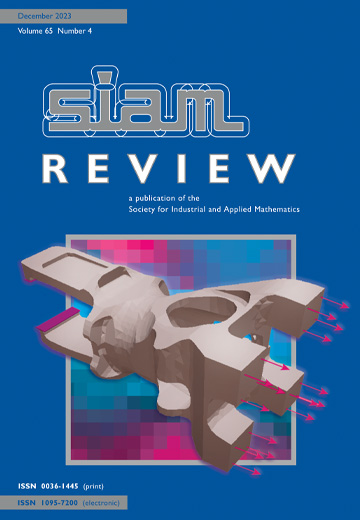Research Spotlights
IF 6.1
1区 数学
Q1 MATHEMATICS, APPLIED
引用次数: 0
Abstract
SIAM Review, Volume 66, Issue 1, Page 89-89, February 2024.As modeling, simulation, and data-driven capabilities continue to advance and be adopted for an ever expanding set of applications and downstream tasks, there has been an increased need for quantifying the uncertainty in the resulting predictions. In “Easy Uncertainty Quantification (EasyUQ): Generating Predictive Distributions from Single-Valued Model Output,” authors Eva-Maria Walz, Alexander Henzi, Johanna Ziegel, and Tilmann Gneiting provide a methodology for moving beyond deterministic scalar-valued predictions to obtain particular statistical distributions for these predictions. The approach relies on training data of model output-observation pairs of scalars, and hence does not require access to higher-dimensional inputs or latent variables. The authors use numerical weather prediction as a particular example, where one can obtain repeated forecasts, and corresponding observations, of temperatures at a specific location. Given a predicted temperature, the EasyUQ approach provides a nonparametric distribution of temperatures around this value. EasyUQ uses the training data to effectively minimize an empirical score subject to a stochastic monotonicity constraint, which ensures that the predictive distribution values become larger as the model output value grows. In doing so, the approach inherits the theoretical properties of optimality and consistency enjoyed by so-called isotonic distributional regression methods. The authors emphasize that the basic version of EasyUQ does not require elaborate hyperparameter tuning. They also introduce a more sophisticated version that relies on kernel smoothing to yield predictive probability densities while preserving key properties of the basic version. The paper demonstrates how EasyUQ compares with the standard technique of applying a Gaussian error distribution to a deterministic forecast as well as how EasyUQ can be used to obtain uncertainty estimates for artificial neural network outputs. The approach will be especially of interest for settings when inputs or other latent variables are unreliable or unavailable since it offers a straightforward yet statistically principled and computationally efficient way for working only with outputs and observations.
研究热点
SIAM 评论》,第 66 卷第 1 期,第 89-89 页,2024 年 2 月。 随着建模、仿真和数据驱动能力的不断进步,并被越来越多的应用和下游任务所采用,量化预测结果中不确定性的需求也日益增加。在 "简易不确定性量化(EasyUQ):中,作者 Eva-Maria Walz、Alexander Henzi、Johanna Ziegel 和 Tilmann Gneiting 提供了一种超越确定性标量值预测的方法,以获得这些预测的特定统计分布。该方法依赖于标量的模型输出-观测对的训练数据,因此不需要访问更高维的输入或潜在变量。作者以数值天气预报为例,说明人们可以获得特定地点温度的重复预测和相应的观测数据。给定预测温度后,EasyUQ 方法会提供围绕该值的非参数温度分布。EasyUQ 利用训练数据有效地最小化了经验分数,并受到随机单调性约束,从而确保预测分布值随着模型输出值的增长而变大。这样,该方法就继承了所谓同调分布回归方法所具有的最优性和一致性的理论特性。作者强调,EasyUQ 的基本版本不需要复杂的超参数调整。他们还介绍了一个更复杂的版本,该版本依靠核平滑来产生预测概率密度,同时保留了基本版本的关键特性。论文展示了 EasyUQ 如何与将高斯误差分布应用于确定性预测的标准技术进行比较,以及 EasyUQ 如何用于获取人工神经网络输出的不确定性估计值。在输入或其他潜在变量不可靠或不可用的情况下,这种方法尤其有意义,因为它为只处理输出和观测数据提供了一种简单明了、符合统计学原理且计算效率高的方法。
本文章由计算机程序翻译,如有差异,请以英文原文为准。
求助全文
约1分钟内获得全文
求助全文
来源期刊

SIAM Review
数学-应用数学
CiteScore
16.90
自引率
0.00%
发文量
50
期刊介绍:
Survey and Review feature papers that provide an integrative and current viewpoint on important topics in applied or computational mathematics and scientific computing. These papers aim to offer a comprehensive perspective on the subject matter.
Research Spotlights publish concise research papers in applied and computational mathematics that are of interest to a wide range of readers in SIAM Review. The papers in this section present innovative ideas that are clearly explained and motivated. They stand out from regular publications in specific SIAM journals due to their accessibility and potential for widespread and long-lasting influence.
 求助内容:
求助内容: 应助结果提醒方式:
应助结果提醒方式:


